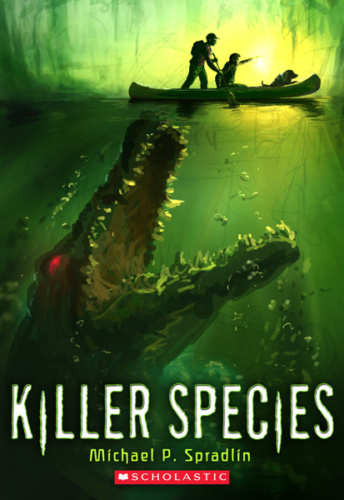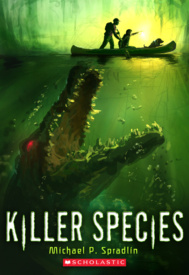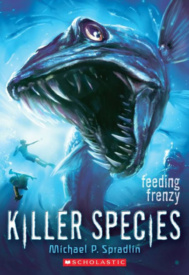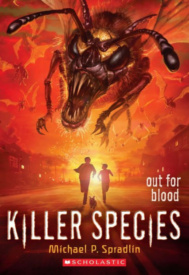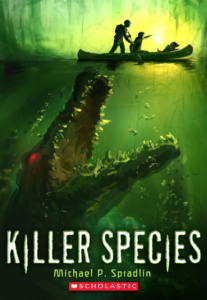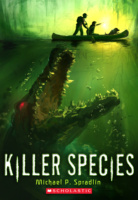Killer Species: Menace from the Deep
Book 1 in the Killer Species Series
A book for Older Kids
Emmet Doyle is not in the best mood when he arrives in Florida City. His father is a wildlife biologist, and has been summoned to the Everglades, dragging Emmet along with him. Though still in mourning from losing his mom a year ago, Emmet is trying hard to keep a good attitude. Upon their arrival, however, things quickly get weird. Dr. Rosalita Geaux, the Park Superintendent, wastes no time in revealing the reason she called Emmet’s father to Florida. A strange creature was recently found dead in the park, and upon seeing it, it becomes clear to everyone that this is not a native species. This creature is man-made. Deep in the swamp, someone has been experimenting to create a new breed of apex predator. And they’re about to set them loose.
Read an Excerpt
Reviews
This is the ideal series for reluctant readers, especially boys, with easy to read short action-packed chapters, terrifying encounters with hybrid gator monsters, crazy escapes and plenty of science. The author effortlessly weaves themes of single parentage, grief, starting over somewhere new and eco-terrorism into the plotline. Future volumes in The Killer Species series promise more of the same.
— Mary Thompson for Dragons Who Read
Enjoy an Excerpt
↓ Jump to Ordering Options
PROLOGUE
Everglades National Park August
The boat slid silently across the surface of the water. At the stern the man turned the tiller to the left on the nearly silent electric motor. The craft responded instantly and he pointed the bow toward a bank of mangrove trees rising up out of the swamp. After thirty yards, he switched the motor off and the boat floated to a stop, the trees another twenty yards away. He flipped on his infrared night vision goggles and studied the trees for heat signatures. Scanning from the far left of the tree line he saw nothing. Then, there it was, a slight movement in the branches of a tree to his right.
The snake was at least twenty to twenty-five feet long. Though reptiles are cold blooded, it still gave off some residual heat from the sunlight it absorbed during the day. Besides, the night vision goggles the man wore were the most advanced in the world. They could detect a heat signature from a burned-out match for three minutes after the flame died. Unlike a warm-blooded mammal, which would show up as bright red in the view-screen, the snake appeared as a light blue image, twisted around the branches of the tree.
He picked up a tablet computer from the console in front of him, touching an icon on the screen. Near the bow of the thirty-foot craft sat two metal cages fastened to the port and starboard sides. Receiving a signal from the tablet, the electronically controlled doors on the cages rose up, and two of his greatest creations, representing years of work, slithered over the side of the boat and slipped into the water.
Were it daytime, and someone could see the creatures swimming toward the trees, they would look like ordinary alligators. But only at first glance. Both were close to twelve feet long and moved effortlessly through the water. They had the familiar snout and scaly skin with bony ridges along the back.
But a biologist or park ranger or anyone more familiar with the species would immediately notice that these two were different. For one thing, most of their bodies rode above the surface of the water rather than below. This was because their lungs were not like those of a normal alligator and were more similar to those found in birds, their distant evolutionary relatives. These lungs held more air, making them more buoyant. When swimming, they floated, though they were still capable of diving beneath the water’s surface and holding their breath for a long time.
The eyes were different as well; less reptilian, sitting higher on the bony structure of the face, and more similar to those one would find on a bird of prey like a hawk or eagle. These alligators possessed superior vision and could even see well beneath the water.
But it was what would happen once they left the water that would send a sense of complete and utter awe through anyone who witnessed it.
The two swimming reptiles hesitated for a moment. This was the most critical part of the man’s experiment, and he held his breath. Another difference between these creatures and a normal alligator was in their elongated neck. Again, it was similar to a bird’s, and they could lift it out of the water, their heads able to move in any direction.
“Come on, my pets,” he whispered, his pulse racing. With no movement by his creations, thoughts of failure entered his mind. In the lab tests they almost immediately zeroed in on their prey. He believed he’d done an adequate job of re-creating the conditions they would face once released into the swamp. But here in the wild, perhaps there were just too many competing odors. His gene splicing and DNA sequencing, which theoretically gave them an enhanced sense of smell, had not accounted for the pungent odors of the swamp.
They floated motionless in the water, moving their heads back and forth. Nothing. He was devastated. He would need to return his specimens to his . . . wait. Something happened. They lowered their heads and swam powerfully toward the trees.
The man would not allow himself to grow too excited yet. The next few minutes would reveal whether his grand experiment to eradicate the Everglades of invasive species would have any chance of working. He found his breath coming in ragged gasps. It was going to work.
And soon the entire world would see it firsthand.
He called these specially altered alligators Pterogators, a name chosen for a specific reason, and soon the whole world would understand why. They reached the bank of trees and silently exited the water. He switched his goggles from infrared to normal night vision to get a clearer view of the events taking place. He pushed another button on the tablet to record the scene before him through his view-screen.
The snake in the tree, fifteen feet above the ground, sensed no danger yet. The two Pterogators split up, each moving toward the trunk of the tree next to where the python rested in the branches above them. They displayed another difference from a normal gator as they walked. These beasts walked on longer legs, each with a more flexible joint in the middle, leading to clawed feet. And claws that were sharper, and far deadlier than those of regular alligators, more closely resembling the talons one would find on a bird of prey.
In the boat, the man couldn’t suppress a grin. It was going better than he could have imagined. He nearly squealed with delight as they walked across the sand, climbing the trees using their clawed feet and jointed legs to pull themselves into the lower branches. They pushed themselves ever upward, using their tails for support. With their improved limbs they were each six feet above the python in a few seconds.
The snake sensed danger, raising its head and flicking its tongue, seeking whatever was out there in the dark. It was at a disadvantage at night. It normally fed on warm-blooded mammals, but these enhanced reptiles now stalking it were cold-blooded they stored heat from the sun, like a reptile, but the man’s changes to their DNA made sure their bodies would not give off enough heat to alert their primary prey. The snake was as good as blind. Its absorbed heat would give it the energy to last through the evening. But it would be sluggish and less aggressive in the dark.
The python moved its head back and forth, slithering down the tree trunk. But it was too late. The Pterogators leapt from their perches in the nearby trees. As they jumped they spread all four legs and a flap of skin opened, connected to their bodies, just above their knee joints. It allowed them to glide from branch to branch, much like their reptilian ancestors, the archosaurs, navigated the canopy of the Cretaceous forest millions of years ago.
They fell upon the snake, their rakish claws carving into the python. The snake turned and struck the closest beast, trying desperately to sink its fangs into the hard, scaly skin. It had no effect. The python struck again and again but could not find purchase on the creature about to destroy it.
The first bites from the genetically superior creatures were devastating. They bit down with a force equivalent to a one-thousand-pound sledgehammer crushing a watermelon, killing the snake instantly. Though it was already dead, the nerves and muscles throughout its body continued to twitch. The gators continued their work, and in less than two minutes the snake was a mass of twisted scales and flesh.
In the boat, the man pumped his fist in quiet glee. Overjoyed at his success, he pushed another button on the tablet and a homing beacon attached to the cages at the bow started pulsating. The signal was transmitted to collars attached to his pets. They scurried down the tree and hurried across the sand, silently entering the water. In a few minutes they reached the boat and crawled back into their cages. The doors slid shut.
The man smiled. His first field test was a complete success. At last he had discovered the answer to the Burmese pythons and the boa constrictors destroying his beloved Everglades. For years he used his status and position in Florida to seek a solution through the government, private foundations, and his own organization, but his suggestions always fell on deaf ears.
Luckily, he had access to resources and the scientific knowledge to bring his plan to reality. He would save the delicate ecological balance of the Everglades. Soon he would prove that his methods were not in vain. He would go down in history with men like John James Audubon, John Muir, and Henry David Thoreau. Men who devoted their lives to saving the land and its creatures.
Soon the world would know his name.
Not yet. But soon.
end of excerpt
Killer Species: Menace from the Deep
by Michael P. Spradlin
is available in the following formats:
Digital:
Print:
→ As an Amazon Associate I earn from qualifying purchases. I also may use affiliate links elsewhere in my site.


